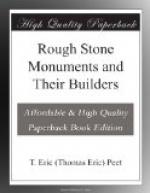Other megalithic structures can be definitely classed as dwellings or tombs, as we have seen in our separate treatment of them. It is not improbable that, if we are right in considering the dolmen as the most primitive form of megalithic monument, megalithic architecture was funerary in origin. Yet, as we find it in its great diffusion, it provides homes for the living as well as for the dead. In their original home, perhaps in Africa, the megalithic race may have lived in huts of wattle or skins, but after their migration the need of protection in a hostile country and the exigencies of a colder climate may have forced them to employ stone for their dwellings. In any case, in megalithic architecture as seen in Europe the tomb and the dwelling types are considerably intermixed, and may have reacted on one another. This, however, does not justify the assertion so often made that the megalithic tomb was a conscious imitation of the hut. It is true that some peoples make the home of their dead to resemble that of the living. Among certain tribes of Greenland it is usual to leave the dead man seated in his hut by way of burial. But such a conception does not exist among all peoples, and to say that the dolmen is an imitation in stone of a hut is the purest conjecture. Still more improbable is Montelius’s idea that the corridor-tomb imitates a dwelling. It is true that the Eskimos have a type of hut which is entered by a low passage often 30 feet in length, but for one who believes as Montelius does that the corridor-tomb is southern or eastern in origin such a derivation is impossible, for this type of house is essentially northern, its aim being to exclude the icy winds. In the south it would be intolerably close, and its low passage besides serving no purpose would be inconvenient.
There is really no reason to derive either the dolmen or the corridor-tomb from dwellings at all. Granted the use of huge stones, both are purely natural forms, and the presence of the corridor in the latter is dictated by necessity. The problem was how to cover a large tomb-chamber with a mound and to leave it still accessible for later interments, and the obvious solution was to add a covered passage leading out to the edge of the mound.
A remarkable feature of the megalithic tombs is the occurrence in many of them of a small round or rectangular hole in one of the walls, usually an end-wall, more rarely a partition-wall between two chambers. Occasionally the hole was formed by placing side by side two upright blocks each with a semicircular notch in its edge. Tombs with a holed block or blocks occur in England, instances being the barrows of Avening and Rodmarton, King Orry’s Grave in the Isle of Man, Lanyon Quoit in Cornwall, and Plas Newydd in Wales, which has two holes. There are also examples in Ireland, France, Belgium, Central Germany, and Scandinavia, where they are common. Passing further afield we find holes in the Giants’ Graves of Sardinia, and in Syria, the Caucasus, and India, where half the dolmens in the Deccan are of this type. The holes are usually too small to allow of the passage of a human body. It has been suggested that they served as an outlet for the soul of the deceased, or in some cases as a means of passing in food to him.




